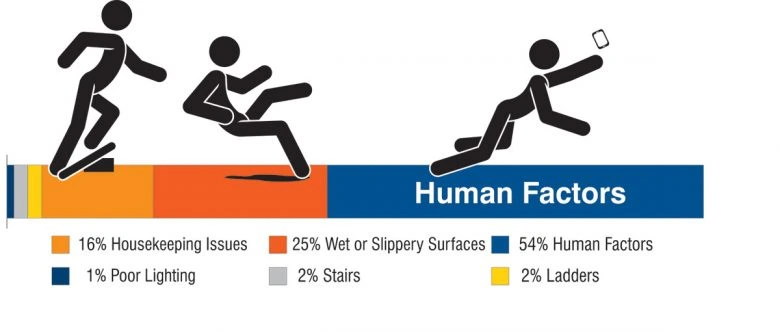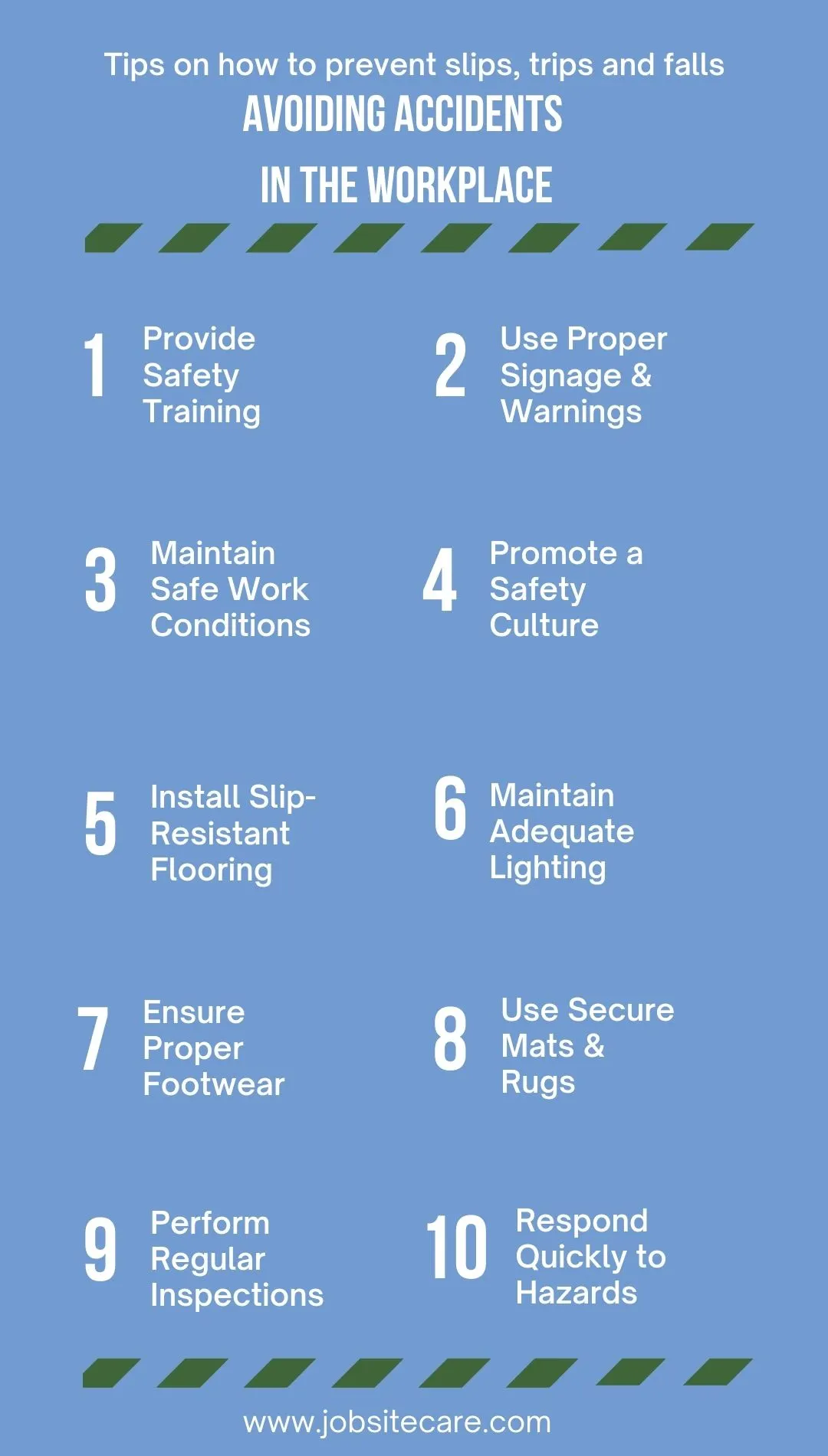Slips, trips, and falls are the second highest single cause of workplace injuries, with 22% of these accidents leading to over a month off work.
With slips, trips, and falls causing nearly 700 fatalities every year—and many more injurious accidents—it’s clear that this is a severe safety issue in the workplace.
And while critical in every industry, safety risks are particularly concerning in high-risk fields like construction. In fact, 1 in 5 workplace deaths occurred in the construction industry in 2022, and 38.4% of these deaths were due to slips, trips, and falls.
That said, both employers and employees must be aware of the risks of slips and falls at work. And since this is a common workplace injury, employers must take the extra step to stay proactive in mitigating risks while fulfilling their responsibilities under workplace safety regulations.
To help bring awareness to this issue, this article discusses the leading causes of slips, trips, and falls, tips for preventing them, and more.
What Are Slips, Trips, and Falls?

According to the Timber Products Manufacturers Association, slips, trips, and falls can be defined as:
- Slips: Slips are a loss of balance caused by too little friction between your feet and the surface you walk or work on.
- Trips: Trips occur whenever your foot hits an object, and you are moving with enough momentum to be thrown off balance.
- Falls: Falls occur whenever you move too far off your center of balance.
In the construction industry and other high-risk work environments, there are a range of situations that can lead to slips, trips, and falls in the workplace, including poorly maintained stairs and ladders, wet floors, loose floorboards, uneven floors, unmarked hazards, unsafe scaffolding, and more.
The Leading Causes of Slips, Trips, and Falls
If your company is interested in preventing slips, trips, and falls, you must first understand their leading causes. Since different risks and hazards contribute to each, we’ve broken down this information into 3 groups:
Slips
Common causes of slips include:
- Wet or Slippery Floors: Wet floors may be due to spilled liquids, cleaning solutions, grease, oil, food debris, rain, or snow.
- Polished or Smooth Floors: If the finish on a polished floor is not properly applied or maintained, then it may provide too little grip, especially in areas like kitchens, hallways, or entrances where the floor may become wet.
- Improper Footwear: Shoes that lack the necessary traction and grip or are not suited for the work environment can cause workplace accidents.
Trips
Common causes of trips include:
- Uneven Surfaces: Loose tiles, changes in floor level, cracked pavement, and potholes can all have roles in safety in the workplace.
- Obstacles and Debris: Clutter—which may be caused by wires, tools, or materials left out in work areas—is a huge hazard in the workplace.
- Cables or Wires: Cables left in high-traffic areas or across walkways can be easily tripped over, especially if they are not secured.
- Rugs and Mats: When not properly secured to the floor, rugs or mats can cause workers to trip due to their tendency to move easily and curl at the edges.
Falls
Common causes of falls include:
- Poor Lighting: Inadequate lighting in stairways, hallways, or workspaces can prevent workers from seeing hazards in their path. This can also lead to eye strain, fatigue, headaches, and stress.
- Unstable Ladders or Stairs: Loose steps, unstable ladders, or broken handrails can lead to falls, particularly when people are climbing or descending.
- Climbing and Working at Heights: Improperly maintained safety devices and equipment, such as guardrails, fall protection, and ladders, can increase the risk of falling.
- Loose Floorboards or Tiles: Loose floorboards can create uneven surfaces, increasing the risk of workers losing their balance and falling.
How to Prevent Slips, Trips, and Falls in the Workplace
To prevent accidents in the workplace, companies must have a comprehensive strategy in place that helps them mitigate risks effectively. From safety training to proper footwear and inspections, here’s what you need to know.

1. Provide Safety Training
Comprehensive training increases safety awareness, thereby helping workers recognize and avoid hazards, understand the importance of reporting them, and foster a culture of safety within the company. A successful training program may include regular training sessions, open communication about hazards, routine safety audits, clear hazard reporting protocols, and safety drills.
2. Use Proper Signage and Warnings
One of the ways to address unsafe working conditions is to implement clear signage around the workplace to alert employees of potential hazards. Depending on the situation, this may include signs indicating wet floors, fall hazards, uneven surfaces, “watch your step” warnings, and more.
3. Maintain Safe Work Conditions
Maintaining safe working conditions should be a top priority for every business, no matter the size or industry. There are various ways to create a safe working environment, such as regularly cleaning walkways, ensuring that all surfaces are in good condition, using personal protective equipment properly, and enforcing effective workplace injury management.
4. Promote a Safety Culture
As an employer or team leader, it’s your responsibility to create a workplace culture that values safety above all. In addition to enforcing standards like reporting hazards immediately and following established safety protocols, you should also prioritize every aspect of your employees’ health—including their mental well-being—to foster a positive work environment.
5. Install Slip-Resistant Flooring
Slip-resistant flooring is crucial in high-risk environments, especially those that are prone to wetness or spills. In industries like construction, some of the areas that are at higher risk of slips, trips, and falls include entryways and exits, staircases and ramps, elevated work platforms, and outdoor work areas that may be exposed to rain.
6. Maintain Adequate Lighting
Ensuring that all areas of your workplace are properly lit improves visibility and makes it easier to spot hazards like uneven surfaces or objects in the way. You can achieve this by assessing the lighting needs of your workplace, choosing the appropriate lighting sources, and monitoring and maintaining the lighting system.
7. Ensure Proper Footwear
One of the keys to preventing slips, trips, and falls is having proper slip-resistant footwear. When choosing the right footwear, employees and employers must also consider safety standards, toe protection, ankle support, and electrical hazard protection to ensure workers are well-equipped for high-risk environments.
8. Use Secure Mats and Rugs
Companies should ensure all mats and rugs are secured to the floor in high-traffic areas. Depending on your specific business needs, you may even consider using anti-slip walkway matting to provide extra stability on unstable surfaces.
9. Perform Regular Inspections
Regular safety inspections help companies identify hazards early on, address them before they cause harm, and ensure compliance. During this inspection, employers can develop a checklist that covers the unique requirements of the job site, aligns with OSHA requirements, and includes corrective actions where necessary.
10. Respond Quickly to Hazards
Companies must respond quickly to hazards to prevent slips and falls at work. You can do so by assessing the situation, following established protocols, and implementing control measures to prevent the escalation of risks.
Responding to a Slip, Trip, or Fall Incident in the Workplace
While the goal is to prevent workplace injuries, employers should also have a comprehensive strategy in place to ensure effective injury response.
Keep reading for tips to improve your company’s strategy for workplace injury care.
Ensure Immediate Medical Care
Injured workers should be quickly assessed and receive prompt medical attention to help reduce recovery time and prevent complications. By having on-site medical support or occupational health telemedicine, your employees can access immediate care, thereby minimizing the risk of further injury and reducing downtime.
At JobSiteCare, we’ll help you create a detailed workplace injury response procedure to ensure your workers receive the medical care they require.
Report the Incident
All slips, falls, and trips in the workplace should be properly documented. By having strict company procedures for incident reporting, you can ensure all necessary details are captured for insurance purposes and regulatory compliance. These reports also give you valuable insight into common causes of injuries, helping you improve your strategy for workplace injury prevention.
Investigate the Cause
All workplace accidents should also be thoroughly investigated. Why?
Because understanding the root causes of incidents helps prevent similar occurrences in the future. In addition to investigating accidents that lead to injuries, OSHA recommends investigating “near misses”—situations in which a worker might have been hurt if the circumstances had been slightly different.
Implement Corrective Actions
With the information gathered from the above steps, employers must then take immediate action to eliminate hazards, which may involve repairing surfaces, improving safety protocols, or even providing additional training. By partnering with a company that provides telemedicine in workplace safety management, you can gain access to immediate care and valuable insights into the root causes of these accidents, enabling you to better address hazards and reduce injuries.
Conclusion
With slips, trips, and falls being among the most common workplace injuries, it’s clear that companies should take a proactive approach to preventing these incidents.
This includes performing regular safety audits to identify and address hazards, providing hands-on employee training, and utilizing industrial medical services to minimize the costs of workplace injuries.
By leveraging JobSiteCare’s expertise in workplace injury support, your company can minimize disruptions, lower workplace claim costs, and reduce OSHA metrics.
Contact us today to learn more about our injury management services.
FAQs About Slips, Trips, and Falls in the Workplace
1. How can employers manage workers’ compensation claims related to slip, trip, and fall injuries?
Employers can streamline claims by implementing strong workplace safety measures, promptly addressing hazards, and ensuring proper documentation of incidents. Proactively reducing these injuries can also help lower the cost of employee health insurance and minimize financial strain on businesses.
2. How often should workplaces conduct hazard assessments to prevent slip, trip, and fall accidents?
Companies should conduct hazard assessments regularly, ideally on a monthly or quarterly basis, to proactively identify and mitigate risks. However, the frequency of these assessments depends on the industry, work environment, and level of risk associated with specific job tasks.
3. What are the legal implications of slip, trip, and fall accidents in the workplace?
Slip, trip, and fall accidents can lead to workers’ compensation claims, regulatory penalties, and potential lawsuits for negligence.
4. Can telemedicine be used to assess the severity of slip, trip, and fall injuries remotely?
Yes, telemedicine can be used to remotely assess the severity of slip, trip, and fall injuries. These services provide quick medical evaluations and treatment recommendations and ensure end-to-end care coordination.
5. What is the role of workplace training in preventing slips, trips, and falls?
Comprehensive training increases safety awareness, thereby helping workers recognize and avoid hazards, understand the importance of reporting them, and foster a culture of safety within the company.
6. How can employees help in preventing slips, trips, and falls in the workplace?
Employees can help prevent slips, trips, and falls by following safety protocols, reporting hazards, wearing appropriate footwear, and keeping work areas clean and free of obstacles.


